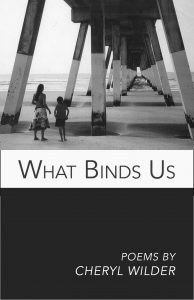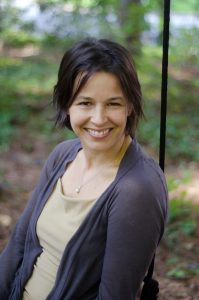
 Review by Carol Dorf
Review by Carol Dorf
The central theme of Cheryl Wilder’s book of poems What Binds Us is family and connection in the face of disconnection. There are poems of estrangement and divorce, and also those of connection. Some of the most interesting poems contain more than one state simultaneously, such as “Foundation,” “Pupa,” and “A Way of Life.”
In both “Pupa” and “A Way of Life, ” Wilder’s concern is the heritage she is giving to her son.
“Pupa” begins,
I point at the spot where my son’s heart beats
and say, ‘there
I’m always right there.’ He’s five and learning how
to take the idea of me with him. I know love does not keep
people from leaving, but I don’t know what does, . . . (7)
When words fail, the narrator holds her small son as a tactile way of communicating their ongoing connection: “with my whole body I hold on / while remaining fragile enough for him to break through.”
Later in “A Way of Life,” the narrator confronts a heritage where her father, “like his father … speaks to no one / but his new wife” (20). She continues in order to find something to tell her son: “. . . And so this is what my son will know of his heritage: / that moving is a way to find home, that those who stay / might not want to be found . . .” (20).
The book also includes poems on caring for her grandmother, and how through caring she finds a modicum of stability in her own life. “Foundation” begins with the grandmother’s weakness:
It took all of my grandmother’s strength
to open and close her curtains weighted
with polyester and years of The Price is Right.” (15)
Then the poem shifts into their relationship and the daily realities of making soup and taking medications while the narrator finds herself in a more stable environment:
. . . The longest I ever lived
in one house was visits to my grandmother.
Barely an adult, I cared for her after bronchitis
flared the emphysema . . .
. . . . . . . . . . . . . . . . . . . . . . . . . . . . . . . . . . . . . .
There was a science to divvying pills into their little boxes . . .
. . . . . . . . . . . . . . . . . . . . . . . . . . . . . . . . . . . . . .
. . . the oxygen machine
whirring her to sleep before I sat across the room on her couch,
both of us breathing and not breathing. (15)
That last line “both of us breathing and not breathing” puts the two of them in a healing proximity.
In the final poem of the book, “To my fiancé,” we get a sense of something new beginning.
We plan for the unknowing . . .
. . . . . . . . . . . . . . . . . . . . . . . . . . . . . . . . . . . . . .
No longer identifiable it wafts sweetly
from petals of a wildflower giving
passersby reassurance of forever
but we know they only smell the moment
one more step and it’s gone. (21)
The reader feels the delicate balance between connection and separation in the scent of the flowers.
I look forward to seeing future books by Cheryl Wilder where she can follow some of those moments.
What Binds Us
by Cheryl Wilder
Finishing Line, 2017, $13.99 [paper]
ISBN 9781635342017
Carol Dorf has two chapbooks available, Some Years Ask (Moria Press) and Theory Headed Dragon (Finishing Line Press.) Her poetry appears in The Mom Egg, Sin Fronteras, E-ratio, Great Weather For Media, About Place, Glint, Slipstream, Surreal Poetics, About Place, The Journal of Humanistic Mathematics, Scientific American, and Maintenant. She is poetry editor of Talking Writing and teaches math in Berkeley.
